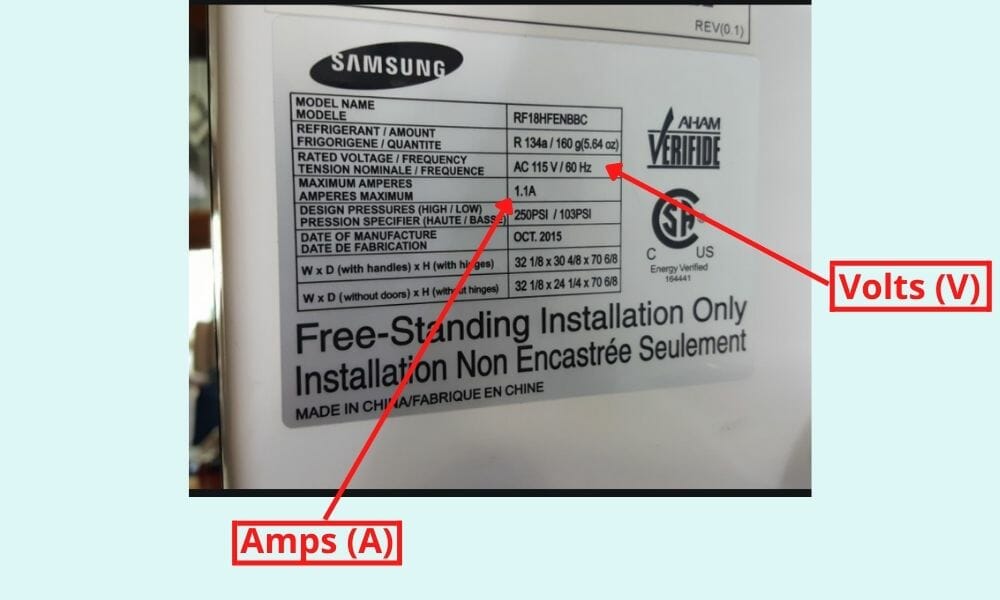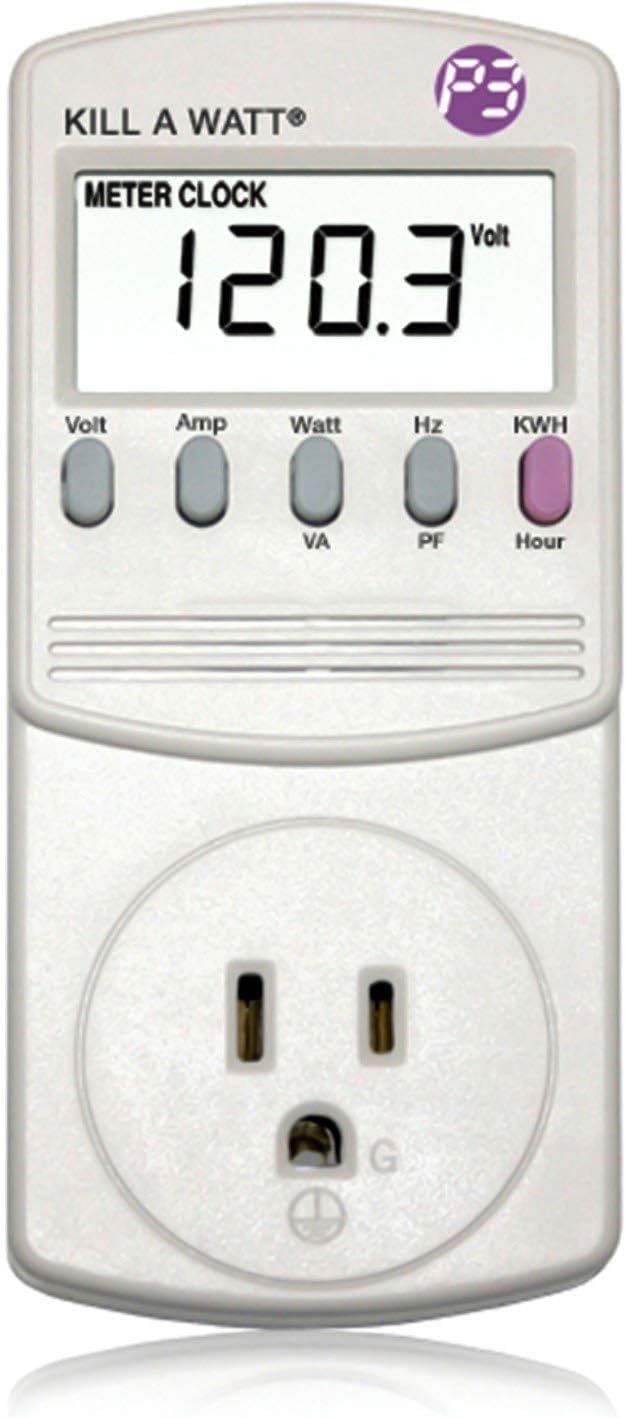If you're planning a road trip or a camping adventure, you may be wondering how long will 200ah battery run a fridge
Recently, I tested my 100ah lithium battery runtime on my 12v RV fridge, and based on my findings,
a 12V 200Ah lithium battery can power a 12V mini RV fridge for about 200 hours or 8 days. A 12V 100Ah lead-acid or AGM battery will run the same fridge for about 90-100 hours due to its 50% depth of discharge limit.
In this article, we'll discuss the factors that affect battery runtime and how to accurately increase your fridge's battery life.
200ah battery runtime on fridge --- how to calculate?
Calculate how long your 200ah battery will last on a fridge by following these two steps.
1. Calculate the power consumption of your fridge
The power consumption of your refrigerator is an important factor to consider when determining the battery runtime of your fridge.
According to industry averages, newer technology refrigerators consume about 60-350 watts of power when running, and 0.5-2.5kWh per day. In contrast, older technology refrigerators manufactured before 2010 consume about 400-700 watts of power and 3.2-5.6kW per day.
To accurately determine the power consumption of your refrigerator, refer to the product description sheet provided with your fridge.

If your fridge is a new model, the company may provide an estimated yearly power consumption. However, if this information is not available, you can calculate the wattage consumption of your fridge by using the formula watts = amps × volts.
For example, let's consider a medium-sized RV fridge with an amp rating of 1.1 and a voltage rating of 115:
Power consumption when running: 115 × 1.1 = 126.5 watt-hours
Therefore, this fridge will consume 126 watts of power when the compressor is running.
Duty Cycle: The fridge operates in cycles where the compressor turns off once the internal temperature of the fridge reaches its set level, known as the duty cycle. As a general rule of thumb, you can divide your fridge's rated wattage consumption by 3 to estimate its actual energy usage.
Using the example of the medium-sized RV fridge mentioned earlier, the power consumption would be:
Power consumption after duty cycle: 126 ÷ 3 = 42 watts
Therefore, in reality, this fridge consumes about 42 watts per hour after considering the duty cycle.
Note: To get started, the fridge requires a surge wattage which is typically 2-3 times higher than the continuous wattage consumption. This is important to keep in mind when selecting the right size inverter to handle the surge wattage.
Must Read: What Size Inverter To Run A Fridge?
Need an easy and accurate solution? To accurately determine the total power consumption of your fridge or any other appliance, use a watt meter. Simply place the meter between the outlet and the fridge cable plug for an easy and accurate solution.
- Monitor your electrical usage by day, week, month, or year
- Large LCD display counts consumption by the kilowatt-hours
2. calculation
After determining the hourly power consumption of your fridge, use our battery runtime calculator to calculate the running hours or follow the steps below to calculate manually.
Assuming you have a small fridge that operates on 12 volts DC and consumes 1 amp per hour (equivalent to 12 watts at 12 volts) after duty cycles, and a 12v 200ah lithium battery.
1. Convert battery amp-hours (Ah) into watt-hours (Wh) using this formula: Battery capacity in watt-hours = Battery amp-hours (Ah) × Battery Volts.
200ah battery in watts = 200 × 12 = 2400 watt-hours 2. Multiply the battery watt-hours by the battery depth of discharge limit. Default battery depth of discharge limit, Lead-acid battery: 50% DoD limit; Lithium: 100% DoD limit.
Battery capacity in wh after DoD limit = 2400 × 100% = 2400wh3. Take into account the battery discharge efficiency rate.
Based on directscience.com data:
- Lead-acid batteries discharge efficiency ≈ 80 − 85%
- Lithium-ion batteries discharge efficiency ≈ 90 − 95%
2400 × 95% = 2160 watt-hours
4. Take into account the inverter efficiency, which is typically around 90%. As we are using a 12v DC fridge for the calculation, we won't consider this step.
5. Divide the battery AC watt-hours by the power consumption of your fridge.
200ah battery runtime on a fridge = 2160 ÷ 12 = 180 hoursMust read: Battery Charge and Discharge Rate Calculator: C-rating To Amps
What Affects how long 200ah battery will run a Fridge?
Several factors can affect the 200ah battery runtime of a fridge, which are:
1. battery chemistry (lead acid, Lithium)
The type of battery used can also affect the length of time a fridge can run on a 200ah battery.
Lithium batteries are more efficient when discharging, meaning they can be used up completely without any issues and with a 95% discharge efficiency rate. As a result, a 200ah lithium battery can provide approximately 190 amp-hours of power.
Lead-acid batteries, should not be discharged beyond 50% of their capacity as it can cause damage to the battery. Additionally, lead acid batteries only have an 80-85% discharge efficiency rate. Therefore, a 200ah lead-acid battery can provide approximately 190 amp-hours of power.
As a result, a lithium battery will provide longer-lasting power for your fridge than a lead-acid battery.
2. Battery voltage
Batteries with higher voltage can hold more power than those with lower voltage.
For example, a 24v 200ah lithium battery can hold 4800 watt-hours of power, whereas a 12v 200ah battery can hold only 2400 watt-hours. This means that a 24v battery will last twice as long as a 12v battery when powering the same fridge.
3. Fridge size
The size of the fridge can have an impact on the battery runtime because larger fridges generally require more power to operate than smaller fridges. This means that a larger fridge will draw more power from the battery, which can result in shorter battery runtime.
Here's a chart showing the different sizes of fridge and their wattage consumption after duty cycles.
| Fridge Size (Cu. ft.) | Wattage Consumption (with duty cycle) |
|---|---|
| 3 cu. ft. | 60 watts |
| 4 cu. ft. | 80 watts |
| 5 cu. ft. | 100 watts |
| 6 cu. ft. | 120 watts |
| 7 cu. ft. | 140 watts |
| 8 cu. ft. | 160 watts |
| 9 cu. ft. | 180 watts |
| 10 cu. ft. | 200 watts |
Note: The above values are estimates and may vary based on the specific model and usage pattern.
4. the Type of fridge You have
If you have a 12v DC fridge, you can connect it directly to a 12v battery without the need for an inverter. This is because the fridge runs on DC power. However, if your fridge requires AC input (120-220v), then you will need an inverter to convert the DC power from the battery into AC power to run the fridge.
Inverters are typically about 90% efficient, meaning 10% of the energy is lost during conversion. If you need an inverter to run your fridge, your battery will run out faster than if you had a fridge that could run on DC power directly from the battery.
5. How much food is in the fridge
A full fridge will retain cold temperatures better than an empty one. Because the food items help to maintain the temperature and reduce the frequency of the compressor turning on. As a result, a fridge with more food in it will require less power to stay cold than an empty one.
This means that if you plan to use a battery-powered fridge, it's a good idea to fill it up as much as possible to maximize its energy efficiency.
6. The outside temperature
This is particularly important to keep in mind if you're planning to use a battery-powered fridge while camping or traveling, as the outside temperature can fluctuate quite a bit.
The fridge's compressor will need to work harder and use more power to maintain a colder temperature if it is hotter outside. On the other hand, if the temperature is cooler, the compressor will not have to work as hard, and the fridge will use less power.
7 Ways to Make Your 200ah Battery last longer on Fridge
To increase the running hours of your 200 amp hour battery on your fridge, Follow these tips:
- Fill up your fridge. A fuller fridge needs less energy to stay cool than an empty one. This is because it takes more energy to cool the air inside the fridge than to cool the food. By filling up your fridge, you reduce the amount of air inside, which means it will require less energy to stay cool.
- Leave space around your fridge. Your fridge needs to exchange heat with the surrounding air to stay cool. If it's too close to other objects, it can't get enough air, and it won't work properly. Leave at least 2 inches of space on all sides of your fridge to make sure it can cool efficiently.
- Cool your fridge down before you use it. Fridges use a lot of energy to get cold. If you cool your fridge down before you plug it in, it won't use as much energy.
- Fourthly, keep your fridge in a cool place. If the air inside your vehicle is cooler than the outside air, put your fridge inside. This will help it stay cool without using as much energy.
- Don't open your fridge too much. When you open the fridge, cold air escapes, and the fridge has to work harder to stay cool. Try to open it as little as possible.
- Store batteries in the right place. To make sure your batteries work well, keep them in a place with the right temperature. Check the battery label or packaging to see what temperature range is best. It's usually between 20-25°C (68-77°F).
- Use eco mode. Some fridges have an eco or low-power mode. This mode uses less energy, but it takes longer to cool things down. If you want to save energy, try using this mode. It will help your battery last longer, and your fridge will still work well.
The bottom line
Based on my test, a 200ah battery will last anywhere between 50-200 hours running a fridge. The specific duration will depend on factors such as the size of your fridge, the type of battery, and the ambient temperature.
You can increase the battery last by reducing your fridge’s power usage by increasing its temperature, keeping it fully stocked, using the eco mode, avoiding frequent opening of the fridge, and storing it in a cool place.
I hope this short guide was helpful to you. still, have any confusion? LEAVE A COMMENT or contact us. Thank You!
Related posts
- Calculate What Size Solar Panel For Fridge
- What Size Solar Panel To Charge 200Ah Battery?
- How Long To Charge 200ah Battery?
Resources
- How many watts does a refrigerator use? - Energysage.com
- How many watts does a fridge use? - solarreviews.com
- How Long Does A Battery Last? - Learnmatrics.com



